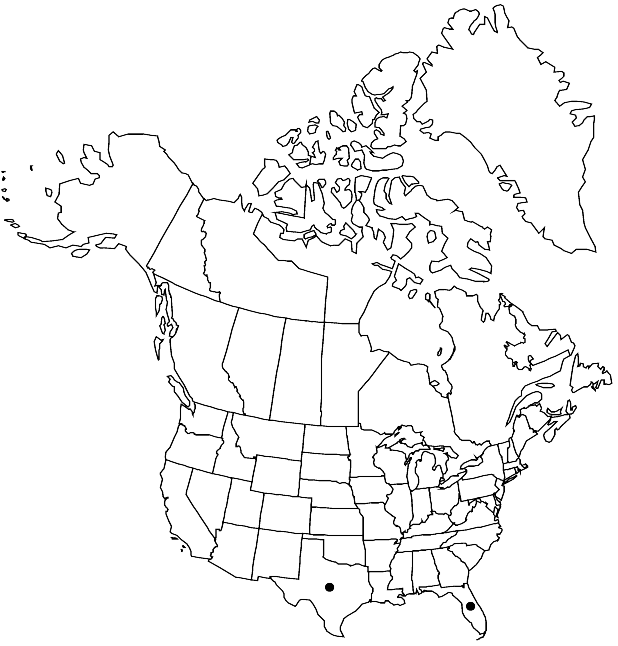Difference between revisions of "Cakile lanceolata"
in I. Urban, Symb. Antill. 3: 504. 1903.
FNA>Volume Importer |
FNA>Volume Importer |
||
| Line 19: | Line 19: | ||
}}<!-- | }}<!-- | ||
| − | --><span class="statement" id="st-undefined" data-properties=""><b>Annuals,</b> (usually sprawling). <b>Stems</b> erect to prostrate, (much-branched), often 5+ dm. <b>Cauline</b> leaves (shortly petiolate or sessile); blade broadly ovate to ovate-lanceolate, or (distal) oblanceolate, (not especially fleshy, smaller distally), margins entire, dentate, or pinnatisect. | + | --><span class="statement" id="st-undefined" data-properties=""><b>Annuals,</b> (usually sprawling). <b>Stems</b> erect to prostrate, (much-branched), often 5+ dm. <b>Cauline</b> leaves (shortly petiolate or sessile); blade broadly ovate to ovate-lanceolate, or (distal) oblanceolate, (not especially fleshy, smaller distally), margins entire, dentate, or pinnatisect. Racemes often 3+ dm; rachis straight. <b>Fruiting</b> pedicels 1.5–4 mm. <b>Flowers</b>: sepals 3.5–5 mm, lateral pair saccate basally; petals usually white, rarely lavender, 4.9–9.4 × 3–4.5 mm, claw distinct. <b>Fruits</b> (weakly 4-angled to terete, striate or sulcate), fusiform or lanceoloid [turbinate], 15–31 × 3–4 mm; proximal segment terete, (5–10 mm); terminal segment slenderly conical, (9–18 mm), apex usually acute. <b>Seeds</b>: cotyledons accumbent or, occasionally, incumbent.</span><!-- |
-->{{Treatment/Body | -->{{Treatment/Body | ||
| Line 67: | Line 67: | ||
|publication year=1903 | |publication year=1903 | ||
|special status= | |special status= | ||
| − | |source xml=https://jpend@bitbucket.org/aafc-mbb/fna-data-curation.git/src/ | + | |source xml=https://jpend@bitbucket.org/aafc-mbb/fna-data-curation.git/src/8f726806613d60c220dc4493de13607dd3150896/coarse_grained_fna_xml/V7/V7_630.xml |
|tribe=Brassicaceae tribe Brassiceae | |tribe=Brassicaceae tribe Brassiceae | ||
|genus=Cakile | |genus=Cakile | ||
Revision as of 17:58, 18 September 2019
Annuals, (usually sprawling). Stems erect to prostrate, (much-branched), often 5+ dm. Cauline leaves (shortly petiolate or sessile); blade broadly ovate to ovate-lanceolate, or (distal) oblanceolate, (not especially fleshy, smaller distally), margins entire, dentate, or pinnatisect. Racemes often 3+ dm; rachis straight. Fruiting pedicels 1.5–4 mm. Flowers: sepals 3.5–5 mm, lateral pair saccate basally; petals usually white, rarely lavender, 4.9–9.4 × 3–4.5 mm, claw distinct. Fruits (weakly 4-angled to terete, striate or sulcate), fusiform or lanceoloid [turbinate], 15–31 × 3–4 mm; proximal segment terete, (5–10 mm); terminal segment slenderly conical, (9–18 mm), apex usually acute. Seeds: cotyledons accumbent or, occasionally, incumbent.
Distribution

s United States, Mexico, West Indies, Central America.
Discussion
Subspecies 4 (3 in the flora).
Subspecies alacranensis is known from the Yucatán Peninsula.
Selected References
None.
Lower Taxa
Key
| 1 | Fruits lanceoloid, apex not tapering abruptly, terminal segment at least 2 times length of proximal segment; leaf blades: margins usually sinuately or crenately lobed, rarely pinnatisect. | Cakile lanceolata subsp. lanceolata |
| 1 | Fruits fusiform or lanceoloid, apex tapering abruptly, terminal segment less than 2 times length of proximal segment; leaf blades: margins pinnatifid or entire | > 2 |
| 2 | Fruits fusiform, not constricted at articulation, 4- or 8-sulcate. | Cakile lanceolata subsp. fusiformis |
| 2 | Fruits lanceoloid, usually constricted at articulation, weakly 4-angled or terete. | Cakile lanceolata subsp. pseudoconstricta |